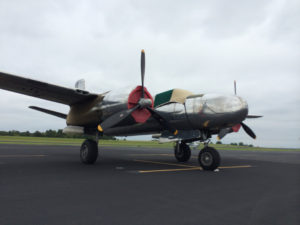Project Description

MPH
WEAPONS
SEATS
A-26 Invader
Role: Ground attack & light bomber
National Origin: United States
Manufacturer: Douglas Aircraft Company
First Flight: 1942
Primary User: US Army Air Forces, US Air Force, US Navy, French Air Force
Number Built: 2452
The Douglas A-26 Invader (designated B-26 between 1948 and 1965) is a United States twin-engined light bomber and attack aircraft that was built by Douglas Aircraft during World War II that also saw service during several of the Cold War’s major conflicts. A limited number of highly modified aircraft (designation A-26) served in combat until 1969.It was found to be a fast aircraft capable of carrying twice its specified bomb load. A range of guns could be fitted to produce a formidable ground-attack aircraft.
A re-designation of the type from A-26 to B-26 led to confusion with the Martin B-26 Marauder, which first flew in November 1940, some 20 months before the Douglas design’s maiden flight. Although both types were powered by the widely used Pratt & Whitney R-2800 Double Wasp eighteen-cylinder, double-row radial engine, they were completely different and separate designs — the Martin bomber originated in 1939, with more than twice as many Marauders (nearly 5,300) produced in comparison to the Douglas design.
General characteristics
- Crew: 3
- Length: 50 ft 0 in (15.24 m)
- Wingspan: 70 ft 0 in (21.34 m)
- Height: 18 ft 3 in (5.64 m)
- Wing area: 540 ft² (50 m²)
- Empty weight: 22,850 lb (10,365 kg)
- Loaded weight: 27,600 lb (12,519 kg)
- Max. takeoff weight: 35,000 lb (15,900 kg)
- Powerplant: 2 × Pratt & Whitney R-2800-27 “Double Wasp” radial engine, 2,000 hp (1,500 kW) each
Performance
- Maximum speed: 355 mph (308 kn, 570 km/h)
- Range: 1,400 mi (1,200 nmi, 2,300 km)
- Service ceiling: 22,000 ft (6,700 m)
- Rate of climb: 1,250 ft/min (6.4 m/s)
- Wing loading: 51 lb/ft² (250 kg/m²)
- Power/mass: 0.145 hp/lb (108 W/kg)
Armament
- Guns:
- 6 or 8 0.50 in (12.7 mm) M2 Browning machine guns in solid, “all purpose” nose: or 2 0.50 in (12.7 mm) M2 machine guns in glass “bombardier” nose
- Up to 8 0.50 in (12.7 mm) M2 machine guns paired in four optional under wing pods: or 3 0.50 in (12.7 mm) M2 machine guns in each outer wing panel
- 2 0.50 in (12.7 mm) M2 machine guns in remote-controlled dorsal turret
- 2 0.50 in (12.7 mm) M2 machine guns in remote-controlled ventral turret
- Rockets: Up to 10 5-inch (12.7 cm) HVAR rockets on “zero length” launch pylons, five under each outer wing panel
- Bombs: Up to 6,000 lb (2,700 kg) capacity – 4,000 lb (1,800 kg) in the bomb bay plus 2,000 lb (910 kg) carried externally on underwing hardpoints